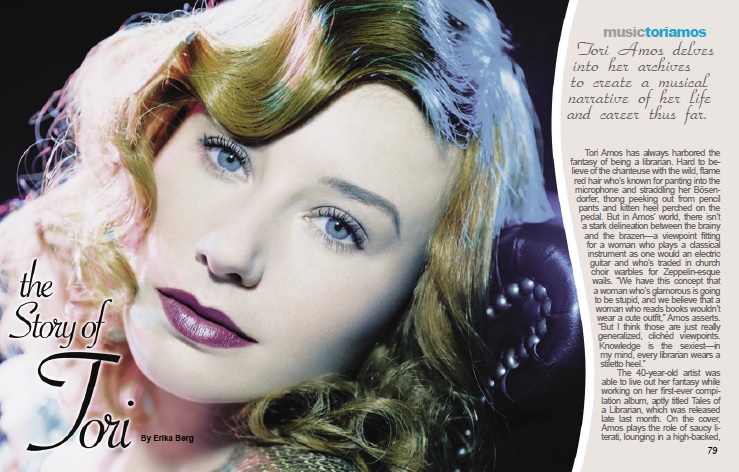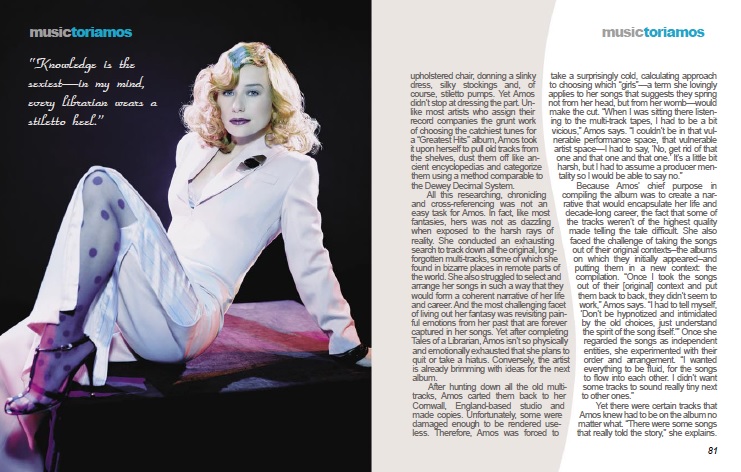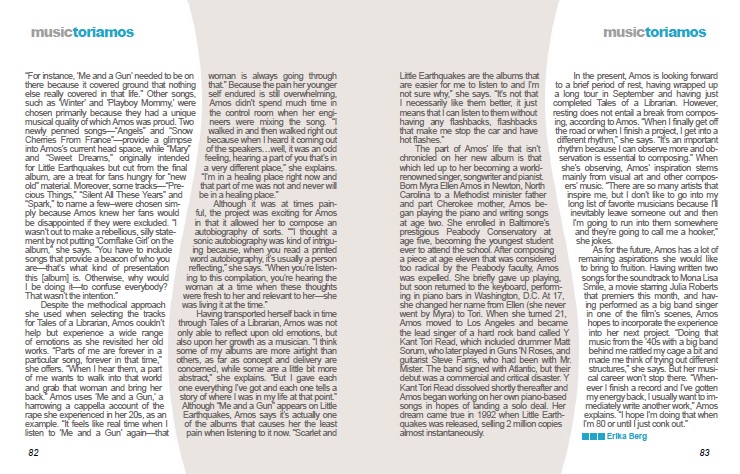|

songs | interviews | photos | tours | boots | press releases | timeline
unknown source (US)
November 2003
[original article .pdf]
the Story of Tori
by Erika Berg
Tori Amos delves into her archives to create a musical narrative of her life and career thus far.
Tori Amos has always harbored the fantasy of being a librarian. Hard to believe of the chanteuse with the wild, flame red hair who's known for panting into the microphone and straddling her Bösendorfer, thong peeking out from pencil pants and kitten heel perched on the pedal. But in Amos' world, there isn't a stark delineation between the brainy and the brazen -- a viewpoint fitting for a woman who plays a classical instrument as one would an electric guitar and who's traded in church choir warbles for Zeppelin-esque wails. "We have this concept that a woman who's glamorous is going to be stupid, and we believe that a woman who reads books wouldn't wear a cute outfit," Amos asserts. "But I think those are just really generalized, clichéd viewpoints. Knowledge is the sexiest -- in my mind, every librarian wears a stiletto heel."
The 40-year-old artist was able to live out her fantasy while working on her first-ever compilation album, aptly titled Tales of a Librarian, which was released late last month. On the cover, Amos plays the role of saucy literati, lounging in a high-backed, upholstered chair, donning a slinky dress, silky stockings and, of course, stiletto pumps. Yet Amos didn't stop at dressing the part. Unlike most artists who assign their record companies the grunt work of choosing the catchiest tunes for a "Greatest Hits" album, Amos took it upon herself to pull old tracks from the shelves, dust them off like ancient encyclopedias and categorize them using a method comparable to the Dewey Decimal System.
All this researching, chronicling and cross-referencing was not an easy task for Amos. In fact, like most fantasies, hers was not as dazzling when exposed to the harsh rays of reality. She conducted an exhausting search to track down all the original, long-forgotten multi-tracks, some of which she found in bizarre places in remote parts of the world. She also struggled to select and arrange her songs in such a way that they would form a coherent narrative of her life and career. And the most challenging facet of living out her fantasy was revisiting painful emotions from her past that are forever captured in her songs. Yet after completing Tales of a Librarian, Amos isn't so physically and emotionally exhausted that she plans to quit or take a hiatus. Conversely, the artist is already brimming with ideas for the next album.
After hunting down all the old multi-tracks, Amos carted them back to her Cornwall, England-based studio and made copies. Unfortunately, some were damaged enough to be rendered useless. Therefore, Amos was forced to take a surprisingly cold, calculating approach to choosing which "girls" -- a term she lovingly applies to her songs that suggests they spring not from her head, but from her womb -- would make the cut. "When I was sitting there listening to the multi-track tapes, I had to be a bit vicious," Amos says. "I couldn't be in that vulnerable performance space, that vulnerable artist space -- I had to say, 'No, get rid of that one and that one and that one.' It's a little bit harsh, but I had to assume a producer mentality so I would be able to say no."
Because Amos' chief purpose in compiling the album was to create a narrative that would encapsulate her life and decade-long career, the fact that some of the tracks weren't of the highest quality made telling the tale difficult. She also faced the challenge of taking the songs out of their original contexts -- the albums on which they initially appeared -- and putting them in a new context: the compilation. "Once I took the songs out of their [original] context and put them back to back, they didn't seem to work," Amos says. "I had to tell myself, 'Don't be hypnotized and intimidated by the old choices, just understand the spirit of the song itself.'" Once she regarded the songs as independent entities, she experimented with their order and arrangement. "I wanted everything to be fluid, for the songs to flow into each other. I didn't want some tracks to sound really tiny next to other ones."
Yet there were certain tracks that Amos knew had to be on the album no matter what. "There were some songs that really told the story," she explains. "For instance, 'Me and a Gun' needed to be on there because it covered ground that nothing else really covered in that life." Other songs, such as 'Winter' and 'Playboy Mommy,' were chosen primarily because they had a unique musical quality of which Amos was proud. Two newly penned songs -- "Angels" and "Snow Cherries From France" -- provide a glimpse into Amos's current head space, while "Mary" and "Sweet Dreams," originally intended for Little Earthquakes but cut from the final album, are a treat for fans hungry for "new old" material. Moreover, some tracks -- "Precious Things," "Silent All These Years" and "Spark," to name a few -- were chosen simply because Amos knew her fans would be disappointed if they were excluded. "I wasn't out to make a rebellious, silly statement by not putting 'Cornflake Girl' on the album," she says. "You have to include songs that provide a beacon of who you are -- that's what kind of presentation this [album] is. Otherwise, why would I be doing it -- to confuse everybody? That wasn't the intention."
Despite the methodical approach she used when selecting the tracks for Tales of a Librarian, Amos couldn't help but experience a wide range of emotions as she revisited her old works. "Parts of me are forever in a particular song, forever in that time," she offers. "When I hear them, a part of me wants to walk into that world and grab that woman and bring her back." Amos uses 'Me and a Gun,' a harrowing a cappella account of the rape she experienced in her 20s, as an example. "It feels like real time when I listen to 'Me and a Gun' again -- that woman is always going through that." Because the pain her younger self endured is still overwhelming, Amos didn't spend much time in the control room when her engineers were mixing the song. "I walked in and then walked right out because when I heard it coming out of the speakers... well, it was an odd feeling, hearing a part of you that's in a very different place," she explains. "I'm in a healing place right now and that part of me was not and never will be in a healing place."
Although it was at times painful, the project was exciting for Amos in that it allowed her to compose an autobiography of sorts. ""I thought a sonic autobiography was kind of intriguing because, when you read a printed word autobiography, it's usually a person reflecting," she says. "When you're listening to this compilation, you're hearing the woman at a time when these thoughts were fresh to her and relevant to her -- she was living it at the time."
Having transported herself back in time through Tales of a Librarian, Amos was not only able to reflect upon old emotions, but also upon her growth as a musician. "I think some of my albums are more airtight than others, as far as concept and delivery are concerned, while some are a little bit more abstract," she explains. "But I gave each one everything I've got and each one tells a story of where I was in my life at that point." Although "Me and a Gun" appears on Little Earthquakes, Amos says it's actually one of the albums that causes her the least pain when listening to it now. "Scarlet and Little Earthquakes are the albums that are easier for me to listen to and I'm not sure why," she says. "It's not that I necessarily like them better, it just means that I can listen to them without having any flashbacks, flashbacks that make me stop the car and have hot flashes."
The part of Amos' life that isn't chronicled on her new album is that which led up to her becoming a world-renowned singer, songwriter and pianist. Born Myra Ellen Amos in Newton, North Carolina to a Methodist minister father and part Cherokee mother, Amos began playing the piano and writing songs at age two. She enrolled in Baltimore's prestigious Peabody Conservatory at age five, becoming the youngest student ever to attend the school. After composing a piece at age eleven that was considered too radical by the Peabody faculty, Amos was expelled. She briefly gave up playing, but soon returned to the keyboard, performing in piano bars in Washington, D.C. At 17, she changed her name from Ellen (she never went by Myra) to Tori. When she turned 21, Amos moved to Los Angeles and became the lead singer of a hard rock band called Y Kant Tori Read, which included drummer Matt Sorum, who later played in Guns 'N Roses, and guitarist Steve Farris, who had been with Mr. Mister. The band signed with Atlantic, but their debut was a commercial and critical disaster. Y Kant Tori Read dissolved shortly thereafter and Amos began working on her own piano-based songs in hopes of landing a solo deal. Her dream came true in 1992 when Little Earthquakes was released, selling 2 million copies almost instantaneously.
In the present, Amos is looking forward to a brief period of rest, having wrapped up a long tour in September and having just completed Tales of a Librarian. However, resting does not entail a break from composing, according to Amos. "When I finally get off the road or when I finish a project, I get into a different rhythm," she says. "It's an important rhythm because I can observe more and observation is essential to composing." When she's observing, Amos' inspiration stems mainly from visual art and other composers' music. "There are so many artists that inspire me, but I don't like to go into my long list of favorite musicians because I'll inevitably leave someone out and then I'm going to run into them somewhere and they're going to call me a hooker," she jokes.
As for the future, Amos has a lot of remaining aspirations she would like to bring to fruition. Having written two songs for the soundtrack to Mona Lisa Smile, a movie starring Julia Roberts that premiers this month, and having performed as a big band singer in one of the film's scenes, Amos hopes to incorporate the experience into her next project. "Doing that music from the '40s with a big band behind me rattled my cage a bit and made me think of trying out different structures," she says. But her musical career won't stop there. "Whenever I finish a record and I've gotten my energy back, I usually want to immediately write another work," Amos explains. "I hope I'm doing that when I'm 80 or until I just conk out."
original article



t o r i p h o r i a
tori amos digital archive
yessaid.com
|